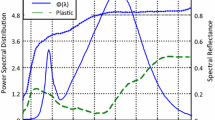Abstract
The emerging cost-efficient visible light communication (VLC)-based indoor wireless network requires an economical solution for backhaul transmission. Non-line-of-sight (non-LOS) VLC links are generally applicable candidates to set up a backhaul network without rearrangement of existing lighting fixtures. Here, we describe non-LOS channels aided by the first-order specular reflection from mirrors, which can be used to overcome the multipath effect of purely diffuse non-LOS channels. Characterizations of purely diffuse and mirror-aided non-LOS channels are conducted with a time-efficient simulation model based on an iterative algorithm. Any bounce of reflections combined with specular and diffuse reflections can be simulated using the proposed iterative VLC model in polynomial time. Simulation results show that mirror-aided non-LOS channels outperform purely diffuse non-LOS links regardless of the link configuration. The effect of concentration and directionality of non-LOS VLC channels is also shown and discussed.











Similar content being viewed by others
References
Tanaka, Y., Komine, T., Haruyama, S., Nakagawa, M.: Indoor visible communication utilizing plural white LEDs as lighting. In: 12th IEEE International Symposium Personal, Indoor and Mobile Radio Communications, vol. 2, pp. 81–85 (2001). https://doi.org/10.1109/PIMRC.2001.965300
Komine, T., Nakagawa, M.: Fundamental analysis for visible-light communication system using LED lights. IEEE Trans. Consum. Electron. 50(1), 100 (2004). https://doi.org/10.1109/TCE.2004.1277847
Grubor, J., Randel, S., Langer, K.D., Walewski, J.W.: Broadband information broadcasting using LED-based interior lighting. J. Lightw. Technol. 26(24), 3883 (2008). https://doi.org/10.1109/JLT.2008.928525
Chen, C., Ijaz, M., Tsonev, D., Haas, H.: Analysis of downlink transmission in DCO-OFDM-based optical attocell networks, In: 2014 IEEE Global Communications Conference. GLOBECOM 2014, pp. 2072–2077 (2014). https://doi.org/10.1109/GLOCOM.2014.7037113
Komine, T., Nakagawa, M.: Integrated system of white LED visible light communication and power line communication. IEEE Trans. Consum. Electron. 49(1), 71 (2003)
Hu, P., Pathak, P.H., Das, A.K., Yang, Z., Mohapatra, P.: PLiFi: hybrid WiFi-VLC networking using power lines. In: 3rd ACM Workshop on Visible Light Communication Systems, VLCS 2016, vol. 03-07-Octo, pp. 31–36 (2016). https://doi.org/10.1145/2981548.2981549
Karunatilaka, D., Zafar, F., Kalavally, V., Parthiban, R.: LED based indoor visible light communications: state of the art. IEEE Commun. Surv. Tutor. 17(3), 1649 (2015). https://doi.org/10.1109/COMST.2015.2417576
Wang, Y., Chi, N., Wang, Y., Tao, L., Shi, J.: Network architecture of a high-speed visible light communication local area network. IEEE Photon. Technol. Lett. 27(2), 197 (2015). https://doi.org/10.1109/LPT.2014.2364955
Kazemi, H., Safari, M., Haas, H.: A wireless backhaul solution using visible light communication for indoor Li-Fi attocell networks. In: IEEE ICC 2017 Optical Networks and Systems Symposium (2017)
Carruthers, J.B., Kahn, J.: Modeling of nondirected wireless infrared channels. IEEE Transactions on Communications 45(10), 1260 (1997)
Chen, C., Basnayaka, D., Haas, H.: Non-line-of-sight channel impulse response characterisation in visible light communications. In: 2016 IEEE International Conference on Communications, ICC 2016 (2016). https://doi.org/10.1109/ICC.2016.7511382
Jungnickel, V., Pohl, V., Nönnig, S., von Helmolt, C.: A physical model of the wireless infrared communication channel. IEEE J. Sel. Areas Commun. 20(3), 631 (2002). https://doi.org/10.1109/49.995522
Lopez-Hernandez, F., Perez-Jimenez, R., Santamaria, A.: Ray-tracing algorithms for fast calculation of the channel impulse response on diffuse IR wireless indoor channels. Opt. Eng. 39, 2775 (2000)
Sarbazi, E., Uysal, M., Abdallah, M., Qaraqe, K.: Indoor channel modelling and characterization for visible light communications. In: International Conference on Transparent Optical Networks, pp. 1–4 (2014). https://doi.org/10.1109/ICTON.2014.6876576
Miramirkhani, F., Uysal, M.: Channel modeling and characterization for visible light communications. IEEE Photon. J. 7(6), 1–16 (2015). https://doi.org/10.1109/JPHOT.2015.2504238
Barry, J.R., Kahn, J., Krause, W.J., Lee, E.A., Messerschmitt, D.G.: Simulation of multipath impulse response for indoor wireless optical channels. IEEE J. Sel. Areas Commun. 11(3), 367 (1993). https://doi.org/10.1109/49.219552
Carruthers, J.B., Kannan, P.: Iterative site-based modeling for wireless infrared channels. IEEE Trans. Antennas Propag. 50(5), 759 (2002). https://doi.org/10.1109/TAP.2002.1011244
Lee, K., Park, H., Barry, J.R.: Indoor channel characteristics for visible light communications. IEEE Commun. Lett. 15(2), 217 (2011). https://doi.org/10.1109/LCOMM.2011.010411.101945
Lopez-Hernandez, F., Betancor, M.: DUSTIN: algorithm for calculation of impulse response on IR wireless indoor channels. Electron. Lett. 33(21), 1804 (1997)
Khalighi, M.A., Uysal, M.: Survey on free space optical communication: a communication theory perspective. IEEE Commun. Surv. Tutor. 16(4), 2231 (2014). https://doi.org/10.1109/COMST.2014.2329501
Aubé, M., Roby, J., Kocifaj, M.: Evaluating potential spectral impacts of various artificial lights on melatonin suppression. Photosynthesis, and star visibility. PLoS ONE 8(7), e67798 (2013). https://doi.org/10.1371/journal.pone.0067798
Baldridge, A.M., Hook, S.J., Grove, C.I., Rivera, G.: The ASTER spectral library version 2.0. Remote Sens. Environ. 113(4), 711 (2009). https://doi.org/10.1016/j.rse.2008.11.007
Gfeller, F.R., Bapst, U.: Wireless in-house data communication via diffuse infrared radiation. Proc. IEEE 67(11), 1474 (1979). https://doi.org/10.1109/proc.1979.11508
Schlick, C.: An inexpensive BRDF model for physically-based rendering (1994). https://doi.org/10.1111/1467-8659.1330233
Arumugam, S., John, J.: Effect of transmitter positions on received power and bandwidth in diffuse indoor optical wireless systems. Opt. Quantum Electron. 39(1), 1 (2007). https://doi.org/10.1007/s11082-007-9064-x
De-La-Llana-Calvo, Á., Lázaro-Galilea, J., Gardel-Vicente, A., Rodríguez-Navarro, D., Bravo-Muñoz, I., Tsirigotis, G., Iglesias-Miguel, J.: Modeling the effect of optical signal multipath. Sensors 17(9), 2038 (2017). https://doi.org/10.3390/s17092038
Armstrong, J.: OFDM for optical communications. J. Lightw. Technol. 27(3), 189 (2009). https://doi.org/10.1109/JLT.2008.2010061
I.T.S. Group, ITU-T Rec. G.975.1 (02/2004) Forward error correction for high bit-rate DWDM submarine systems. Technical report (2005)
Lu, J.: M-PSK and M-QAM BER computation using signal-space concepts. IEEE Trans. Commun. (1999). https://doi.org/10.1109/26.752121
Author information
Authors and Affiliations
Corresponding author
Additional information
Publisher’s Note
Springer Nature remains neutral with regard to jurisdictional claims in published maps and institutional affiliations.
Rights and permissions
About this article
Cite this article
Wu, Y., Audenaert, P., Pickavet, M. et al. Mirror-aided non-LOS VLC channel characterizations with a time-efficient simulation model. Photon Netw Commun 38, 151–166 (2019). https://doi.org/10.1007/s11107-019-00841-3
Received:
Accepted:
Published:
Issue Date:
DOI: https://doi.org/10.1007/s11107-019-00841-3




